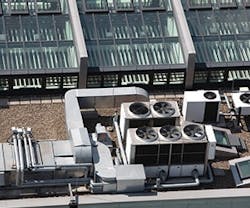Timely HVAC Tips from ENERGY STAR
Are you doing your best to keep buildings in optimal temperature range? The shift from heating to cooling season is prime time for occupant discomfort.
Taking matters into their own hands, occupants frequently adjust wall thermostats, throwing off controls and causing unintended energy consumption within a building. Likewise, temperature sensors may drift over time and increase heating and cooling loads, in turn leading back to occupant discomfort.
It’s a vicious cycle. Don’t tune out the red flags. Take the following measures from ENERGY STAR to tune up the heating and cooling controls and components in your facility.
- Calibrate the indoor and outdoor building sensors. Calibration of room thermostats, duct thermostats, humidistats, and pressure and temperature sensors should be in accordance with the original design specifications. Calibrating these controls may require specialized skills or equipment and you may need to call for outside expertise.
- Inspect damper and valve controls to make sure they are functioning properly. Check pneumatically controlled dampers for leaks in the compressed-air hoses. Also examine dampers to ensure that they open and close properly. Stiff dampers can cause improper modulation of the amount of outside air being used in the supply airstream. In some cases, dampers may actually be wired in a single position or disconnected, violating minimum outside air requirements.
- Refine building operating schedules. HVAC controls must be adjusted to heat and cool the building properly during occupied hours. Occupancy schedules can change frequently over the life of a building, and control schedules should be adjusted accordingly. Operating schedules should also be adjusted to reflect daylight savings time. When the building is unoccupied, set the temperature back to save some heating or cooling energy, but keep in mind that some minimum heating and cooling may be required when the building is unoccupied. In cold climates, for example, heating may be needed to keep water pipes from freezing.
- Review the utility rate schedule. Utilities typically charge on-peak and off-peak times within a rate, which can dramatically affect the amount of electric bills. If possible, equipment should run during the less expensive off-peak hours. For certain buildings, precooling and/or preheating strategies may be called for.
- Chiller tube cleaning and water treatment. These tasks can improve the performance of a chiller system by providing cleaner surfaces for heat transfer on both the refrigerant and water sides of the chiller tube.
Tune-ups are also helpful during the recommissioning process. Savings from these tune-up measures can range up to 30% of annual heating and cooling costs, notes ENERGY STAR.
